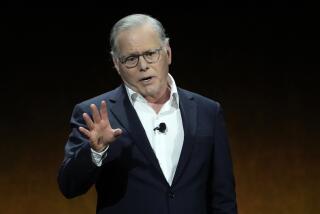Biotech Executive Pay On the Rise, Study Says : Salaries: But Robert E. Draper, chief executive at National Health Laboratories, earned $1,443,521 in 1991, to place first on list of county’s highest paid executives.
- Share via
If a grand theme can be extracted from this year’s survey of the county’s highest paid public company executives, it may be that biotechnology has become an increasingly lucrative career.
Although biotechnology companies represent just a small percentage of the county’s publicly held companies, their executives have claims on a disproportionate share of the higher paying jobs. And, although few are in the upper reaches of the survey--those making more than, say, $300,000 per annum--a couple of dozen are in the more than $100,000 category.
What makes that unusual is that until recent years, biotechnology has not been known as a high paying profession, with most executives and scientists agreeing to defer big salaries now in exchange for the chance to make really big money later in the form of bonuses and stock options in the event their companies develop products and go public.
In one sense, the rise in biotechnology salaries reflects the relative scarcity of management personnel in a highly specialized industry, one in which successful executives often have advanced degrees and experience in both science and business.
The county’s highest paid executive at a San Diego County public company is Robert E. Draper, chief executive at La Jolla-based National Health Laboratories, a chain of independent clinical laboratories. Draper was paid $1,443,521 in 1991, of which $500,000 was in incentive and discretionary cash bonuses.
A 20-year employee of the chain, Draper has overseen the company’s rapid and profitable expansion in recent years. Sales and profits grew to $603.9 million and $103.9 million respectively in 1991 from $270.7 million and and $35.3 million in 1987.
The company was a wholly owned subsidiary of Revlon in 1985 when Revlon was acquired by financier Ronald O. Perelman. Since then, Perelman has slowly spun off pieces of National Health Laboratories stock to the public to the point that the laboratory chain is now 80% owned by the public.
The proposed merger of San Diego Gas & Electric with SCEcorp, parent of Southern California Edison, may have been quashed by the state Public Utilities Commission, but that didn’t keep SDG&E; chief executive Thomas Page, a strong proponent of the merger, from becoming the county’s second highest paid executive at $1,248,790.
By far the most controversial of 1991 compensation packages was the $1,237,041 pulled down by HomeFed Corp. President Thomas Wageman for six months of work, after Wageman was recruited with regulators’ blessing in a bid to save the troubled thrift.
The unusual and controversial aspect of Wageman’s compensation was that he received an $859,366 relocation benefit, ostensibly for moving to San Diego from his former job in Dallas. But Wageman ended up simply taking the cash and buying another home in Dallas.
Fourth highest paid was former Magma Power President Arnold (Bud) Johnson with $967,018, of which $397,629 was salary and bonus and the rest stock options and awards. Johnson retired last June after leading the geothermal power company along a path to big profits and big expansion of its power generation capacity.
Rohr President Robert Goldsmith earned $776,704, a 94% increase over the previous year, in a year that saw Chula Vista-based Rohr and other aerospace companies buffeted by a downturn in commercial jet airliner orders and in defense contracts.
Three other top executives at National Health Laboratories--Bernard Statland, John Markus and David Flaugh--were in the county’s top 10 list of most highly paid executives. Each benefited greatly from incentive and discretionary bonuses awarded by the company’s board.
The highest paid biotechnology executives were Molecular Biosystems Chairman Kenneth Widder and President Vincent Frank who earned $430,000 and $425,000, respectively. The company’s principal product Albunex, an imaging agent used in ultrasound diagnostic tests, is still in development. Albunex has completed clinical trials, and the company is awaiting a thumbs up or thumbs down from the federal Food and Drug Administration on whether it can begin marketing.
Other highly paid biotechnology executives were Immune Response President James Glavin and Executive Vice President Dennis Carlo, who each earned $351,193. Immune Response’s stock soared earlier this year to $62--before settling back down to its current $20 range.
More to Read
Inside the business of entertainment
The Wide Shot brings you news, analysis and insights on everything from streaming wars to production — and what it all means for the future.
You may occasionally receive promotional content from the Los Angeles Times.










